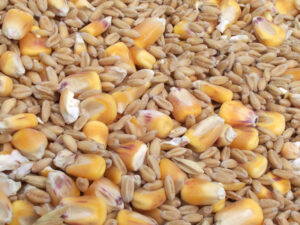
According to Serbian Economist, Serbia and Ukraine are intensifying cooperation in agriculture, trade, and technology exchange.
The Serbian side confirmed its interest in expanding imports of Ukrainian agricultural products, especially corn, wheat, oilseeds, and semi-finished products for the food industry. At the same time, they discussed increasing supplies of Serbian goods to the Ukrainian market, including meat, dairy products, feed, and planting material.
According to the Serbian Ministry of Agriculture, Kyiv and Belgrade are considering the possibility of creating joint logistics corridors that would allow them to bypass existing transit restrictions and speed up the movement of goods between the countries. Special attention was paid to the topic of plant protection, veterinary standards, and simplifying certification procedures for producers in both countries.
The parties also noted the potential for cooperation in the development of digital agriculture and agrotechnologies. Ukraine offered Serbian companies an exchange of practices on the use of drones, remote monitoring systems, and AI analytics to optimize agricultural production. The Serbian delegation, in turn, expressed its willingness to share its experience in organic farming and agricultural raw material processing.
During the meeting, the prospects for Serbian companies’ participation in programs to restore Ukraine’s agricultural infrastructure, including the modernization of grain storage, processing facilities, and logistics, were also discussed.
The negotiations are taking place against the backdrop of growing trade turnover: in recent years, the volume of bilateral trade in agricultural products has shown steady growth, and Serbia is becoming one of Ukraine’s key Balkan partners in the region.
The next meeting of the relevant ministries is expected to take place in early 2026, where the parties plan to present a roadmap for deepening cooperation in the agricultural sector.

As of October 24, farmers harvested 37.560 million tons of grain and legumes from 8.400 million hectares, which is 73% of the area sown with these crops, according to the Ministry of Economy, Environment, and Agriculture on its website.
Last year, on the same date, 45.1 million tons of grain were harvested from 9.7 million hectares, meaning that this year’s figures are 16.7% and 13.4% lower, respectively, mainly due to the later start of the corn harvest.
As noted by the Ministry of Economy, 7.71 million tons of corn have been harvested from 1.31 million hectares, while last year at approximately the same date, 15.4 million tons were harvested from 2.7 million hectares.
As for wheat, its harvest is slightly higher than last year’s – 22.80 million tons from 5.05 million hectares compared to 22.30 million tons from 4.9 million hectares, while barley is slightly lower – 5.37 million tons from 1.35 million hectares compared to 5.50 million tons from 1.41 million hectares.
This year’s pea harvest is significantly higher – 662,300 tons from 271,500 hectares compared to 465,300 tons from 212,200 hectares last year, while buckwheat and millet are still significantly lower – 83,300 tons versus 126,900 tons and 61,500 tons versus 159,500 tons, respectively.
The harvest of other cereals and legumes this year reached 876,700 tons from 317,600 hectares as of October 24, while last year it amounted to 1.1 million tons on the same date.
It is noted that among the leaders are, in particular, the Odesa region – 3.80 million tons from an area of 1.14 million hectares, Poltava – 2.86 million tons from 603.3 thousand hectares, Khmelnytskyi region – 2.55 million tons from 365,200 hectares, and Chernihiv region – 2.52 million tons from 407,700 hectares.
The harvest of wheat, barley, and peas has been completed, according to the Ministry of Economy.
As for oilseeds, the rapeseed harvest has already been completed, and it turned out to be only slightly less than last year’s – 3.32 million tons against 3.5 million tons from almost equal areas of about 1.3 million hectares.
However, the harvest of soybeans and sunflowers is still ongoing, and there is a significant lag: 3.50 million tons of soybeans have been harvested from 1.52 million hectares, compared to 5.6 million tons from 2.5 million hectares on the same date last year, while sunflower seeds – 7.84 million tons from 4.24 million hectares compared to 9.5 million tons from 4.6 million hectares.
In addition, sugar beet harvesting is also lagging behind: 5.64 million tons have been harvested from an area of 108,100 hectares, compared to 8.3 million tons from 170,600 hectares on the same date last year.
According to the Ministry of Economy, sunflowers have been harvested from 82% of the sown area, soybeans from 70%, and sugar beets from 55%.
In its Inflation Report published at the end of July, the National Bank of Ukraine lowered its forecast for this year’s grain harvest from 61.7 million tons to 57.9 million tons, and for oilseeds from 22 million tons to 21 million tons.
The NBU recalled that last year, the grain harvest in Ukraine fell to 56.2 million tons from 59.8 million tons in 2023, while oilseeds fell from 21.7 million tons to 20 million tons.
According to forecasts by Deputy Minister of Economy Taras Vysotsky, this year’s grain harvest will be around 56 million tons, the same as last year.

As of October 17, farmers harvested 34.749 million tons of grain and legumes from 7.979 million hectares, which is 69% of the area sown with these crops, according to the website of the Ministry of Economy, Environment, and Agriculture.
Last year, on the same date, 42.8 million tons of grain were harvested from 9.4 million hectares, meaning that this year’s figures are 18.8% and 15% lower, respectively, mainly due to the later start of corn harvesting.
As noted by the Ministry of Economy, 4.91 million tons of corn have been harvested from 895,200 hectares, while last year at around this date, 13.2 million tons were harvested from 2.4 million hectares.
As for wheat, its harvest is slightly higher than last year’s – 22.78 million tons from 5.05 million hectares compared to 22.30 million tons from 4.9 million hectares, while barley is slightly lower – 5.36 million tons from 1.35 million hectares compared to 5.50 million tons from 1.41 million hectares.
This year’s pea harvest is significantly higher – 658,300 tons from 271,100 hectares compared to 465,300 tons from 212,200 hectares last year, while buckwheat and millet are still significantly lower – 82.4 thousand tons versus 124.8 thousand tons and 59.9 thousand tons versus 158.9 thousand tons, respectively.
The harvest of other cereals and legumes this year reached 896,200 tons from 304,700 hectares as of October 17, while last year it amounted to 1 million tons on the same date.
It is noted that among the leaders are, in particular, the Odesa region – 3.78 million tons from an area of 1.13 million hectares, Poltava – 2.66 million tons from 564,200 hectares, Khmelnytskyi region – 2.48 million tons from 356,900 hectares, and Vinnytsia region – 2.45 million tons from 440,100 hectares.
The harvest of wheat, barley, and peas has been completed, according to the Ministry of Economy.
As for oilseeds, the rapeseed harvest is only slightly less than last year’s – 3.31 million tons compared to 3.5 million tons from almost equal areas of about 1.3 million hectares.
However, the harvest of soybeans and sunflowers is still ongoing, and there is a significant lag: 3.08 million tons of soybeans have been harvested from 1.34 million hectares, compared to 5.2 million tons from 2.3 million hectares on the same date last year, while sunflower seeds – 7.19 million tons from 3.91 million hectares compared to 9.3 million tons from 4.5 million hectares.
In addition, the harvest of sugar beets is also lagging behind: 4.72 million tons have been harvested from an area of 90,000 hectares, compared to 6.5 million tons on the same date last year.
According to the Ministry of Economy, sunflower has been harvested from 76% of the sown area, soybeans from 62%, and sugar beets from 45%, while rapeseed harvesting has been completed.
In its Inflation Report published at the end of July, the National Bank of Ukraine lowered its forecast for this year’s grain harvest from 61.7 million tons to 57.9 million tons, and for oilseeds from 22 million tons to 21 million tons.
The NBU recalled that last year, the grain harvest in Ukraine fell to 56.2 million tons from 59.8 million tons in 2023, while oilseeds fell from 21.7 million tons to 20 million tons.
According to forecasts by Deputy Minister of Economy Taras Vysotsky, this year’s grain harvest will be around 56 million tons, the same as last year.

According to data from the Food and Agriculture Organization of the United Nations (FAO), in 2024 Ukraine ranked 9th in the world in wheat production, producing about 23.4 million tons of grain. This information is presented in a new study by Experts Club, based on FAOSTAT statistics and the video “Wheat Production by Country (1991–2024)”.
The top three wheat producers remain traditionally stable:
China — 136 million tons,
India — 113.9 million tons,
Russia — 81.6 million tons.
These three countries account for nearly half of global wheat production and play a crucial role in the world’s agricultural system.
They are followed by:
United States — 53.6 million tons,
France — 35.9 million tons,
Canada — 35.9 million tons,
Australia — 34.1 million tons,
Pakistan — 31.4 million tons,
Ukraine — 23.4 million tons,
Germany — 21.5 million tons.
The second ten producers are opened by Turkey (19 million tons) and Kazakhstan (18.6 million tons), with Italy (6.9 million tons) closing the list.
The Experts Club video analysis demonstrates significant structural changes in global wheat production over the past three decades. The video covers the period from 1991 to 2024. During this time, China and India have almost doubled their production thanks to increased yields and consistent government support for the agricultural sector.
Russia and Ukraine, after a sharp decline in the 1990s, made a remarkable recovery: in the early 1990s, Ukraine produced around 15 million tons, while by 2024 the volume had increased to 23–24 million tons — despite war-related risks and export restrictions.
Kazakhstan, traditionally focused on exports, has maintained its position, supplying grain to Central Asia and parts of China.
Despite military actions and damage to part of its infrastructure, Ukraine remains one of the world’s leading wheat exporters. The main factors behind this are high yields in southern and central regions, improved logistics through Danube ports, and export routes via Romania and Bulgaria.
According to FAO, in 2024 Ukraine exported about 17 million tons of wheat, keeping the country among the three largest global grain suppliers, along with Russia and the United States.
Experts from Experts Club note that growth in production across Asia and CIS countries compensates for declining yields in Europe and North America, which are affected by droughts and climate change. At the same time, Turkey, Iran, and Egypt are strengthening their roles as regional centers of processing and import.
Global markets expect wheat prices to stabilize within the range of 230–250 USD per ton, provided there are no new geopolitical shocks.
“Ukraine’s position in the TOP-10 global wheat producers is a testament to the resilience of its agricultural sector, even during wartime. With the expansion of domestic processing, Ukraine can reach 25–27 million tons of production in the coming years and strengthen its place among the world’s top five exporters.
At the same time, the grain market is becoming increasingly technology-driven: digitalization of agribusiness, precision farming, and climate-resilient wheat varieties will determine leadership in the next decade,” said Maksym Urakin, co-founder of the analytical center Experts Club.
Ukraine remains one of the few countries where the agricultural sector accounts for about 40% of foreign currency earnings. In 2024, wheat ranked second in export volume after corn, and revenues from grain sales exceeded 6 billion USD.
According to Experts Club forecasts, if the pace of infrastructure recovery continues and weather conditions remain favorable, Ukraine’s wheat production may reach 25 million tons in 2025, and exports could exceed 18 million tons.
The study was prepared by the analytical center Experts Club based on data from FAOSTAT, USDA, and IGC.
The video analysis “Wheat Production by Country 1991–2024” is available on the Experts Club Ukraine YouTube channel.
AGRICULTURE, EXPERTS CLUB, EXPORT, FAO, GLOBAL PRODUCTION, UKRAINE, WHEAT

In its August report, the US Department of Agriculture (USDA) increased the forecast for the harvest of Ukrainian corn in 2022/2023 marketing year (MY, July-June) compared to July by 5 million tons – up to 30 million tons from 25 million tons, and its export estimate has been raised by 3.5 million tons to 12.5 million tons from 9 million tons.
According to a report on the website of the US Department of Agriculture, the estimate of domestic corn consumption in Ukraine has been increased by 1 million tons – from 9.5 million tons to 10.5 million tons.
In the new forecast, the agency also increased the forecast for wheat exports from Ukraine in 2022/2023 MY by 1 million tons – up to 11 million tons from 10 million tons, while the assessment of its harvest remained at the same level – 19.5 million tons. At the same time, the forecast for its domestic consumption in Ukraine was also left at the same level of 10.2 million tons.
In addition, the forecast for carry-over stocks of wheat at the end of the current marketing year has been reduced – from 5.24 million tons to 4.24 million tons compared to 5.84 million tons at its beginning.
According to the report, in general, the forecast for the feed grain harvest in Ukraine for 2022/23 MY was increased by 5.7 million tons – up to 37.46 million tons from 31.76 million tons, and its export – by 3.5 million tons, up to 14 .33 million tons from 10.83 million tons.
As reported, since the beginning of MY 2022/2023, Ukraine has exported 2.21 million tons of grain and leguminous crops, which is 2.1 times less than in the previous MY. The country supplied to foreign markets 1.45 million tons of corn (26.1% more than in 2021/2022 MY), 562 thousand tons of wheat (3.2 times less), 192 thousand tons of barley (8.4 times less) and 5.1 thousand tons of flour (3.2 times less).

Turkey plans to lease land from other countries for crop production, which will help the country overcome the food crisis caused by Russian aggression against Ukraine and the consequences of the COVID-19 pandemic.
Turkey is considering leasing agricultural land in 10 countries, including Ukraine, Latin America and Africa, Turkish Minister of Agriculture and Forestry Vahit Kirişci told Türkiye.
“Part of the negotiations with 10 countries, including Ukraine and some countries of Latin America and Africa, ended with an agreement, and contacts with some of them continue. Agricultural products that cannot be produced in Turkey for climatic reasons will be grown on the leased lands or the production of which is insufficient,” the publication said.
It is specified that Turkish private business will also be involved in projects on leased lands. For example, in Sudan, Turkey will grow pineapples, mangoes, avocados, rapeseed, sunflowers, corn, cotton, sesame, sugarcane and alfalfa, the production of which is insufficient in Turkey.
Türkiye specifies that the leased areas will focus on the cultivation of plants that can be used in the production of animal feed. In addition, it is planned to establish the production of wheat there, which will be processed in Turkey and then exported in the form of biscuits, pasta and bulgur.
“We want to bring modern agriculture there. We want to produce in untouched agricultural areas. There are very serious untouched areas, especially in southern Africa. We are able to grow plants in these regions,” the Turkish minister was quoted as saying.